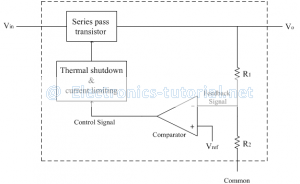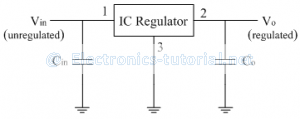IC Regulators:
The discrete component regular circuit such as zener voltage regulator is not much used in practice. Nowadays the circuits are integrated and are available in the form of small IC packages.
Advantages of IC regulators:
1. It is very easy to use.
2. It greatly simplifies the power supply design.
3. IC regulators are small in size thus overall size of the power supply can be reduced.
4. Cost is very less.
5. IC regulators are versatile.
6. IC regulators are provided with features like built in protection, programmable output, current/voltage boosting, internal short circuit, current limiting etc.
Block diagram of IC regulator:
The following figure shows the block diagram of three terminal IC regulator.
It has three terminals.
1. input voltage (Vin)
2. Output voltage (Vo)
3. Common terminal (Ground).
The block diagram is basically of a series voltage regulator. A part of output voltage is taken with the help of potential divider formed by R1 and R2. This is compared with reference voltage; Vref internally generated using zener diode.
After comparison a control signal is generated and is applied through protective circuit to the series pass transistor working as control element. The control signal adjusts the control element in such a way that output voltage remains constant.
Thermal shut down means that the chip(IC) will automatically turn itself off if the internal temperature exceeds, typically 175°C.
The current limiting circuit will protect the chip from excessive load current. Because of thermal shutdown and current limiting, the IC voltage regulator chip is almost indestructible.
Symbolically the three terminal IC regulators are represented as shown below.
The capacitor Cin is required if the regulator is located at an appreciable distance (more than 5 cm) from filter. The output capacitor Co improves the transient response of the regulator. This capacitor also reduces the noise present at the output.
The difference between Vin and Vo (i.e. Vin-Vo) is called as drop-out voltage and must be typically 2V to 3V for proper operation of the regulator.
The IC regulators can supply load currents from 100mA to 5A.

